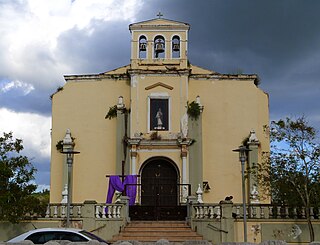See also
- Botijo, a traditional Spanish porous clay container designed to contain water
Botija or Botijas may refer to:

Aibonito is a small mountain town and municipality in Puerto Rico located in the Sierra de Cayey mountain range, north of Salinas; south of Barranquitas and Comerío; east of Coamo; and west of Cidra, and Cayey. Aibonito is spread over 8 barrios and Aibonito Pueblo. It is part of the San Juan-Caguas-Guaynabo Metropolitan Statistical Area.
Trujillo or Truxillo may refer to:

Aguas Buenas,, popularly known as "La Ciudad de las Aguas Claras" or "The City of Clear Waters", is a town and municipality of Puerto Rico located in the Central Mountain Range, north of Cidra, south of Bayamón, Guaynabo and San Juan; east of Comerio; and north-west of Caguas. Aguas Buenas is spread over 9 barrios and Aguas Buenas Pueblo. It is part of the San Juan-Caguas-Guaynabo Metropolitan Statistical Area.

Comerío is a town and municipality of Puerto Rico in the center-eastern region of island, north of Aibonito; south of Naranjito and Bayamón; east of Barranquitas; and west of Cidra and Aguas Buenas. Comerío is spread over 7 barrios and Comerío Pueblo. It is part of the San Juan-Caguas-Guaynabo Metropolitan Statistical Area.

Corozal is a town and municipality of Puerto Rico located in the central-eastern region, north of Orocovis and Barranquitas; south of Vega Alta; southwest of Toa Alta; east of Morovis and Orocovis; and west of Naranjito. Corozal is spread over 12 barrios and Corozal Pueblo. It is part of the San Juan-Caguas-Guaynabo Metropolitan Statistical Area.

Maricao is a town and the second-least populous municipality of Puerto Rico; it is located at the western edge of the Cordillera Central. It is a small town set around a small square in hilly terrain, north of San Germán, Sabana Grande and Yauco; south of Las Marías and Lares, southeast of Mayagüez, and west of Adjuntas. Maricao is spread over 6 barrios and Maricao Pueblo.

Orocovis is a town and municipality of Puerto Rico located in the center of the island. Founded by Juan Rivera de Santiago in 1825. Orocovis is spread over 17 barrios. It is part of the San Juan-Caguas-Guaynabo Metropolitan Statistical Area. It's located north of Villalba and Coamo; south of Morovis and Corozal; southeast of Ciales; east of Jayuya; and west of Barranquitas

Toa Alta is a town and municipality of Puerto Rico located in the northern coast of the island, north of Naranjito; south of Dorado and Toa Baja; east of Vega Alta and Corozal; and west of Bayamón. Toa Alta is spread over eight barrios and Toa Alta Pueblo. It is part of the San Juan-Caguas-Guaynabo metropolitan statistical area. There are nine barrios in Toa Alta and altogether in 2020 had a population of 66,852. Río de la Plata, is a large river that runs through Toa Alta. Toa Alta celebrates its patron saint festival in May.

Vega Baja is a town and municipality located on the coast of north central Puerto Rico. It is north of Morovis, east of Manatí, and west of Vega Alta. Vega Baja is spread over 14 barrios. The population of the municipality was 54,414 at the 2020 census. It is part of the San Juan–Caguas–Guaynabo metropolitan statistical area.

The Rafael Cordero Santiago Port of the Americas —Spanish: Puerto de las Américas Rafael Cordero Santiago (PLA)— is a megaport currently under construction in Ponce, Puerto Rico. The project aims to convert the current Port of Ponce into a value-added tax-free customs-free international shipping hub similar to, though not as large as, the megaports located in Singapore and Rotterdam. The Port of the Americas is Puerto Rico's main Caribbean port, and, at a depth of 50 feet, it is also the deepest port in the Caribbean.

The Puerto Rico Planning Board created in the May 12, 1942 during Rexford G. Tugwell's governorship as the Puerto Rico Planning, Urbanization, and Zoning Board, is the only government agency in charge of centralized planning under the American flag. Its creation was in keeping with Tugwell's New Deal philosophy that Puerto Rico should operate under a highly centralized, all-encompassing territorial government.

"Esperanza" is a song by Spanish singer Enrique Iglesias for his third studio album Cosas del Amor (1998). It was co-written by Iglesias and Chein García-Alonso with Rafael Pérez-Botija handling its production. A power ballad, it is a confessional song of love and forgiveness. Upon "Esperanza"'s release, one reviewer lauded Iglesias's vocals and the song's arrangements while another found it too similar to his debut single "Si Tú Te Vas". Filmed in Malibu, California, the accompanying music video for "Esperanza" was directed by Emmanuel Lubezki, which won Video of the Year at the 11th Annual Lo Nuestro Awards in 1999. "Esperanza" also won "Song of the Year" and an American Society of Composers, Authors and Publishers (ASCAP) Latin Award in the same year. Commercially, it reached number one in Guatemala, Nicaragua, and Panama as well as the Billboard Hot Latin Songs and Latin Pop Airplay charts in the United States, while becoming a top-five hit in Colombia, Costa Rica, Honduras and El Salvador.
Botijuela may refer to:
The barrios of Puerto Rico are the primary legal divisions of the seventy-eight municipalities of Puerto Rico. Puerto Rico's 78 municipios are divided into geographical sections called barrios and, as of 2010, there were 902 of them.

Confidencias is a studio album released by Spanish performer Rocío Dúrcal in 1981 under the label of Ariola Records. It was written and produced by Spanish songwriter Rafael Pérez Botija. In Spain this album was released under the title La gata.

Botija is a municipality located in the province of Cáceres, Extremadura, Spain. According to the 2013 census (INE), the municipality has a population of 193 inhabitants.

Juan Morel Campos is a statue to the memory of a Puerto Rican composer and danza master Juan Morel Campos located at Plaza Las Delicias in Ponce, Puerto Rico. The statue's large marble pedestal follows in the Beaux Arts architectural tradition. Within the pedestal are the mortal remains of the composer.

Jaguas is a barrio in the municipality of Gurabo, Puerto Rico. Its population in 2010 was 2,083.

Botijas is a barrio in the municipality of Orocovis, Puerto Rico. Its population in 2010 was 3,720.

Puerto Rico Highway 568 (PR-568) is a road that travels from the municipality of Orocovis to Corozal in Puerto Rico. With a length of 30.1 km (18.7 mi), it begins at its intersection with PR-5155 in downtown Orocovis and ends at PR-159 in western Corozal.